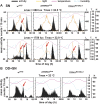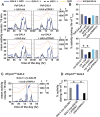dTRPA1 Modulates Afternoon Peak of Activity of Fruit Flies Drosophila melanogaster
- PMID: 26226013
- PMCID: PMC4520709
- DOI: 10.1371/journal.pone.0134213
dTRPA1 Modulates Afternoon Peak of Activity of Fruit Flies Drosophila melanogaster
Abstract
Daily rhythms in Drosophila under semi-natural conditions (or SN) have received much recent attention. One of the striking differences in the behaviour of wild type flies under SN is the presence of an additional peak of activity in the middle of the day. This is referred to as the afternoon peak (A-peak) and is absent under standard laboratory regimes using gated light and temperature cues. Although previous reports identified the physical factors that contribute towards the A-peak there is no evidence for underlying molecular mechanisms or pathways that control A-peak. We report that the A-peak is mediated by thermosensitive dTRPA1 (drosophila Transient Receptor Potential- A1) ion channels as this peak is absent in dTRPA1 null mutants. Further, when natural cycles of light and temperature are simulated in the lab, we find that the amplitude of the A-peak is dTRPA1-dependent. Although a few circadian neurons express dTRPA1, we show that modulation of A-peak is primarily influenced by non-CRY dTRPA1 expressing neurons. Hence, we propose that A-peak of activity observed under SN is a temperature sensitive response in flies that is elicited through dTRPA1 receptor signalling.
Conflict of interest statement
Figures






Similar articles
-
dTRPA1 in Non-circadian Neurons Modulates Temperature-dependent Rhythmic Activity in Drosophila melanogaster.J Biol Rhythms. 2016 Jun;31(3):272-88. doi: 10.1177/0748730415627037. Epub 2016 Feb 11. J Biol Rhythms. 2016. PMID: 26868037
-
A Subset of Circadian Neurons Expressing dTRPA1 Enables Appropriate Phasing of Activity Rhythms in Drosophila melanogaster Under Warm Temperatures.J Biol Rhythms. 2023 Aug;38(4):341-357. doi: 10.1177/07487304231159713. Epub 2023 Apr 27. J Biol Rhythms. 2023. PMID: 37102578
-
Loss of Drosophila melanogaster TRPA1 Function Affects "Siesta" Behavior but Not Synchronization to Temperature Cycles.J Biol Rhythms. 2015 Dec;30(6):492-505. doi: 10.1177/0748730415605633. Epub 2015 Oct 12. J Biol Rhythms. 2015. PMID: 26459465
-
Temperature sensation in Drosophila.Curr Opin Neurobiol. 2015 Oct;34:8-13. doi: 10.1016/j.conb.2015.01.002. Epub 2015 Jan 21. Curr Opin Neurobiol. 2015. PMID: 25616212 Free PMC article. Review.
-
The Drosophila TRPA1 Channel and Neuronal Circuits Controlling Rhythmic Behaviours and Sleep in Response to Environmental Temperature.Int J Mol Sci. 2017 Oct 3;18(10):2028. doi: 10.3390/ijms18102028. Int J Mol Sci. 2017. PMID: 28972543 Free PMC article. Review.
Cited by
-
Drosophila Populations Reared Under Tropical Semi-natural Conditions Evolve Season-dependent Differences in Timing of Eclosion.Front Physiol. 2022 Jul 15;13:954731. doi: 10.3389/fphys.2022.954731. eCollection 2022. Front Physiol. 2022. PMID: 35910567 Free PMC article.
-
Road to sexual maturity: Behavioral event schedule from eclosion to first mating in each sex of Drosophila melanogaster.iScience. 2023 Jul 28;26(9):107502. doi: 10.1016/j.isci.2023.107502. eCollection 2023 Sep 15. iScience. 2023. PMID: 37636050 Free PMC article.
-
Light triggers a network switch between circadian morning and evening oscillators controlling behaviour during daily temperature cycles.PLoS Genet. 2022 Nov 11;18(11):e1010487. doi: 10.1371/journal.pgen.1010487. eCollection 2022 Nov. PLoS Genet. 2022. PMID: 36367867 Free PMC article.
-
Multiple Phototransduction Inputs Integrate to Mediate UV Light-evoked Avoidance/Attraction Behavior in Drosophila.J Biol Rhythms. 2019 Aug;34(4):391-400. doi: 10.1177/0748730419847339. Epub 2019 May 29. J Biol Rhythms. 2019. PMID: 31140349 Free PMC article.
-
CRYPTOCHROME mediates behavioral executive choice in response to UV light.Proc Natl Acad Sci U S A. 2017 Jan 24;114(4):776-781. doi: 10.1073/pnas.1607989114. Epub 2017 Jan 6. Proc Natl Acad Sci U S A. 2017. PMID: 28062690 Free PMC article.
References
-
- Glaser FT, Stanewsky R (2005) Temperature synchronization of the Drosophila circadian clock. Curr Biol 15: 1352–1363. - PubMed
-
- Miyasako Y, Umezaki Y, Tomioka K (2007) Separate sets of cerebral clock neurons are responsible for light and temperature entrainment of Drosophila circadian locomotor rhythms. J Biol Rhythms 22: 115–126. - PubMed
Publication types
MeSH terms
Substances
Grants and funding
LinkOut - more resources
Full Text Sources
Other Literature Sources
Molecular Biology Databases
Miscellaneous

